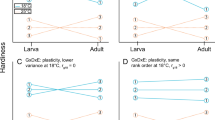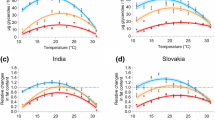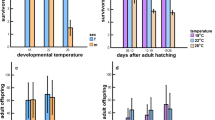Abstract
Beneficial acclimation hypothesis (BAH) is the phenotypic plasticity in response to changing environments which enables organisms to enhance their fitness. In recent years, however, BAH has received vigorous criticism and is still debatable. In this study, we tested thermal hardiness phenotypes (melanization, chill coma recovery, heat knockdown and percentage survival) on adult and pre-adult stages of Drosophila nepalensis, reared in different thermal environments (14, 17, 21 and 25 °C) to check whether increasing natural surrounding temperature and acclimation limit towards environmental change is detrimental or beneficial. Results showed that rearing D. nepalensis at higher temperatures (21 and 25 °C) reduces its melanization and cold hardiness but improves heat knockdown times. When temperature was raised to 26.2 °C (0.6 °C above the upper thermal maxima), to determine the short-term acclimation effects, survival and fitness of adults diminished approximately 1.5 to 2 folds. These results suggest that D. nepalensis has long-term developmental acclimation to both heat and cold which would be extremely beneficial as temperatures and climates alter in the region due to global warming. However, a lack of short-term heat acclimation suggests that rapid shifts in thermal extreme could be detrimental to D. nepalensis.




Similar content being viewed by others
References
Addo-Bediako A, Chown SL, Gaston KJ (2000) Thermal tolerance, climatic variability and latitude. Proc R Soc B 267:739–745. https://doi.org/10.1098/rspb.2000.1065
Angilletta MJ (2009) Thermal adaptation. A theoretical and empirical synthesis. Oxford University Press, Oxford
Bernardo J, Spotila JR (2006) Physiological constraints on organismal response to global warming: mechanistic insights from clinally varying populations and implications for assessing endangerment. Biol Lett 2:135–139. https://doi.org/10.1098/rsbl.2005.0417
Bradshaw AD (1984) Citation classic—evolutionary significance of phenotypic plasticity in plants. Agric Biol Environ 21:20–20
Chamaille-Jammes S, Massot M, Aragon P, Clobert J (2006) Global warming and positive fitness response in mountain populations of common lizards Lacerta vivipara. Glob Chang Biol 12:392–402. https://doi.org/10.1111/j.1365-2486.2005.01088.x
Chevin LM, Lande R, Mace GM (2010) Adaptation, plasticity, and extinction in a changing environment: towards a predictive theory. PLoS Biol 8:e1000357
Chown SL, Terblanche JS (2007) Physiological diversity in insects: ecological and evolutionary contexts. Adv Insect Physiol 33:50–152. https://doi.org/10.1016/S0065-2806(06)33002-0
Donnelly A, Caffarra A, Diskin E, Kelleher CT, Pletsers A, Proctor H, Stirnemann R, Jones MB, O’Halloran J, O’Neill Bf PJ, Sparks T (2011) Climate warming results in phenotypic and evolutionary changes in spring events: a mini-review. Cambridge University Press, Cambridge, pp 176–200
Fellowes MDE, Kraaijeveld AR, Godfray HCJ (1998) Trade-off associated with selection for increased ability to resist parasitoid attack in Drosophila melanogaster P Roy Soc. B-Biol Sci 265:1553–1558. https://doi.org/10.1098/rspb.1998.0471
Fellowes MDE, Kraaijeveld AR, Godfray HCJ (1999) Association between feeding rate and parasitoid resistance in Drosophila melanogaster. Evolution 53:1302–1305. https://doi.org/10.2307/2640834
Forsman A (1997) Thermal capacity of different colour morphs in the pygmy grasshopper Tetrix subulata. Ann Zool Fenn 34:145–149
Freda PJ, Alex JT, Morgan TJ, Ragland GJ (2017) Genetic decoupling of thermal hardiness across metamorphosis in Drosophila melanogaster. Integr Comp Biol 57(5):999–1009
Freda PJ, Ali ZM, Heter N, Ragland GJ, Morgan TJ (2019) Stage-specific genotype-by-environment interactions for cold and heat hardiness in Drosophila melanogaster. Heredity 123(4):479–491
Gilbert AL, Lattanzio MS (2016) Ontogenetic Variation in the Thermal Biology of Yarrow’s Spiny Lizard, Sceloporus jarrovii. PLos ONE 11:e0146904
Harris RM, McQuillan P, Hughes L (2013) A test of the thermal melanism hypothesis in the wingless grasshopper Phaulacridium vittatum. J Insect Sci 13(1):51
Hochachka P, Somero G (1984) Biochemical adaptation. Princeton University Press Princeton, New Jersey
Hochachka PW, Somero GN (2002) Biochemical adaptation: mechanism and process in physiological evolution. Oxford University Press, Oxford
Hoffmann AA (2010) Physiological climatic limits in Drosophila: patterns and implications. J Exp Biol 213:870–880. https://doi.org/10.1242/jeb.037630
Hoffmann AA, Weeks A (2007) Climatic selection on genes and traits after a 100 year-old invasion: a critical look at the temperate-tropical. clines in Drosophila melanogaster from eastern Australia. Genetica 129:133–147
Hoffmann AA, Sørensen JS, Loeschcke V (2003) Adaptation of Drosophila to temperature extremes: bringing together quantitative and molecular approaches. J Therm Biol 28(3):175–216
Hoffmann AA, Sgro CM, Weeks A (2004) Chromosomal inversion polymorphisms and adaptation. Trends Ecol Evol 19:482–488
Huey R, Berrigan D (1996) Testing evolutionary hypotheses of acclimation. In: Animals and temperature: phenotypic evolutionary adaptation, vol 59, pp 205–237
Huey RB, Deutsch CA, Tewksbury JJ, Vitt LJ, Hertz PE, Perez HJA, Garland T (2009) Why tropical forest lizards are vulnerable to climate warming. Proc R Soc B 276:1939–1948. https://doi.org/10.1098/rspb.2008.1957
Krebs RA, Loeschcke V (1995) Resistance to thermal stress in preadult Drosophila buxzatii: variation among populations and changes in relative resistance across life stages. Biol J Linn Soc 56:517–531
Kimura MT (2004) Cold and heat tolerance of drosophilid flies with reference to their latitudinal distributions. Oecologia 140:442–449. https://doi.org/10.1007/s00442-004-1605-4
Kingsolver JG, Huey RB (1998) Evolutionary analyses of morphological and physiological plasticity in thermally variable environments. Am Zool 38:545–560
Lande R (2009) Adaptation to an extraordinary environment by evolution of phenotypic plasticity and genetic assimilation. J Evol Biol 22:1435–1446
Leroi AM, Bennett AF, Lenski RE (1994) Temperature-acclimation and competitive fitness—an experimental test of the beneficial acclimation assumption. Proc Acad Sci USA 91:1917–1921. https://doi.org/10.1073/pnas.91.5.1917
Levins R (1969) Thermal acclimation and heat resistance in Drosophila species. Am Nat 103:483–499
Loeschcke V, Krebs RA (1996) Selection for heat-shock resistance in larval and in adult Drosophila buzzattii: comparing direct and indirect responses. Evolution 50:2354–2359. https://doi.org/10.2307/2410704
Nakamura K, Sheps S, Arck PC (2008) Stress and reproductive failure: past notions, present insights and future directions. J Assist Reprod Gen 25:47–62. https://doi.org/10.1007/s10815-008-9206-5
Nilsson-Örtman V, Johansson F (2017) The rate of seasonal changes in temperature alters acclimation of performance under climate change. Am Nat 190(6):743–761
Okada T (1955) COMPARATIVE MORPHOLOGY OF THE DROSOPHILID FLIES II: Phallic organs of the subgenus Drosophila. 昆蟲 23:97
Palutikof J (2007) Impacts, adaptation and vulnerability Contribution of working group II to the fourth assessment report of the intergovernmental panel on
Parkash R, Lambhod C, Singh D (2014) Thermal developmental plasticity affects body size and water conservation of Drosophila nepalensis from the Western Himalayas. Bull Entomol Res 104:504–516. https://doi.org/10.1017/S0007485314000340
Parkash R, Ramniwas S, Kajla B (2013) Climate warming mediates range shift of two differentially adapted stenothermal Drosophila species in the Western Himalayas. J Asia-Pac Entomol 16:147–153
Partridge L, Barrie B, Fowler K, French V (1994) Thermal evolution of pre-adult life-history traits in Drosophila-melanogaster. J Evolution Biol 7:645–663. https://doi.org/10.1046/j.1420-9101.1994.7060645.x
Piersma T, Drent J (2003) Phenotypic flexibility and the evolution of organismal design. Trends Ecol Evol 18:228–233. https://doi.org/10.1016/s0169-5347(03)00036-3
Portner HO, Knust R (2007) Climate change affects marine fishes through the oxygen limitation of thermal tolerance. Science 315:95–97. https://doi.org/10.1126/science.1135471
Price TD, Qvarnström A, Irwin DE (2003) The role of phenotypic plasticity in driving genetic evolution. Proc R Soc Lond Ser B 270:1433–1440
Rajpurohit S, Nedved O, Gibbs AG (2013) Meta-analysis of geographical clines in desiccation tolerance of Indian drosophilids . Comp Biochem Phys A 164:391–398. https://doi.org/10.1016/j.cbpa.2012.11.013
Rajpurohit S, Parkash R, Niwas S (2008) Climatic changes and shifting species boundaries of drosophilids in the Western Himalaya. Acta Entomol Sin 51:328
Ruibal R (1961) Thermal relations of five species of tropical lizards . Evolution 15:98–111
Sgrò C, Terblanche JS, Hoffmann AA (2016) What can plasticity contribute to insect responses to climate change? Annu Rev Entomol 61:433–451. https://doi.org/10.1146/annurev-ento-010715-023859
Schlichting CD (1986) The evolution of phenotypic plasticity in plants . Annu Rev Ecol Syst 17:667–693. https://doi.org/10.1146/annurev.es.17.110186.003315
Schlichting CD, Pigliucci M (1998) Phenotypic evolution: a reaction norm perspective. Sinauer Associates Incorporated, Sunderland
Somero GN (1995) Proteins and temperature. Ann Rev Physiol 57:43–68
Talekar N, Shelton A (1993) Biology, ecology, and management of the diamondback moth. Ann Rev Entomol 38:275–301
van Dooremalen C, Berg MP, Ellers J (2013) Acclimation responses to temperature vary with vertical stratification: implications for vulnerability of soil-dwelling species to extreme temperature events. Glob Change Biol 19(3):975–984
Via S, Gomulkiewicz R, Dejong G, Scheiner SM, Schlichting CD, Vantienderen PH (1995) Adaptive phenotypic plasticity—consensus and controversy. Trends Ecol Evol 10:212–217. https://doi.org/10.1016/S0169-5347(00)89061-8
Visser ME (2008) Keeping up with a warming world; assessing the rate of adaptation to climate change. Proc R Soc B 275:649–659. https://doi.org/10.1098/rspb.2007.0997
Walther GR, Beißner S, Burga CA (2005) Trends in the upward shift of alpine plants. J Veg Sci 16:541–548
West-Eberhard MJ (2003) Developmental plasticity and evolution. Oxford University Press, New York
Williams SE, Shoo LP, Isaac JL, Hoffmann AA, Langham G (2008) Towards an integrated framework for assessing the vulnerability of species to climate. Chang PLos Biol 6:2621–2626 (:ARTN e32510.1371/journal.pbio.0060325)
Willott SJ, Hassall M (1998) Life-history responses of British grasshoppers (Orthoptera: Acrididae) to temperature change. Funct Ecol 12:232–241 doi. DOI https://doi.org/10.1046/j.1365-2435.1998.00180.x
Wilson RS, Franklin CE (2002) Testing the beneficial acclimation hypothesis. Trends Ecol Evol 17:66–70. https://doi.org/10.1016/S0169-5347(01)02384-9
Acknowledgements
SR is grateful to the Department of Science and Technology (DST), New Delhi for the financial support through the SP/YO/775/2018G project and DS is grateful to Council of Scientific & Industrial Research for the financial support through 09/1260(0001)/2019-EMR-I.
Author information
Authors and Affiliations
Corresponding authors
Ethics declarations
Conflict of interest
Authors declare no conflict of interest.
Additional information
Publisher's Note
Springer Nature remains neutral with regard to jurisdictional claims in published maps and institutional affiliations.
Rights and permissions
About this article
Cite this article
Ramniwas, S., Kumar, G. & Singh, D. Rejection of the beneficial acclimation hypothesis (BAH) for short term heat acclimation in Drosophila nepalensis. Genetica 148, 173–182 (2020). https://doi.org/10.1007/s10709-020-00100-8
Received:
Accepted:
Published:
Issue Date:
DOI: https://doi.org/10.1007/s10709-020-00100-8




